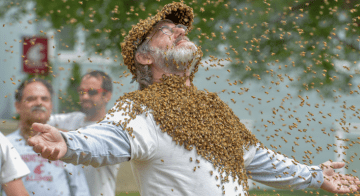Merlin Sheldrake in Nautilus:
 If anyone knows about going fungal, it’s Paul Stamets. I have often wondered whether he has been infected with a fungus that fills him with mycological zeal—and an irrepressible urge to persuade humans that fungi are keen to partner with us in new and peculiar ways. I went to visit him at his home on the west coast of Canada. The house is balanced on a granite bluff, looking out to sea. The roof is suspended on beams that look like mushroom gills. A Star Trek fan since the age of 12, Stamets christened his new house Starship Agarikon—agarikon is another name for Laricifomes officinalis, a medicinal wood-rotting fungus that grows in the forests of the Pacific Northwest.
If anyone knows about going fungal, it’s Paul Stamets. I have often wondered whether he has been infected with a fungus that fills him with mycological zeal—and an irrepressible urge to persuade humans that fungi are keen to partner with us in new and peculiar ways. I went to visit him at his home on the west coast of Canada. The house is balanced on a granite bluff, looking out to sea. The roof is suspended on beams that look like mushroom gills. A Star Trek fan since the age of 12, Stamets christened his new house Starship Agarikon—agarikon is another name for Laricifomes officinalis, a medicinal wood-rotting fungus that grows in the forests of the Pacific Northwest.
…In Stamets’ world, fungal solutions run amok. Give him an insoluble problem and he’ll toss you a new way it can be decomposed, poisoned, or healed by a fungus. Fungi are veteran survivors of ecological disruption. Their ability to cling on—and often flourish—through periods of catastrophic change is one of their defining characteristics. They are inventive, flexible, and collaborative. With much of life on Earth threatened by human activity, are there ways we can partner with fungi to help us adapt? Stamets and a growing number of mycologists think exactly this. Many symbioses have formed in times of crisis. The algal partner in a lichen can’t make a living on bare rock without striking up a relationship with a fungus. Might it be that we can’t adjust to life on a damaged planet without cultivating new fungal relationships?
More here.
